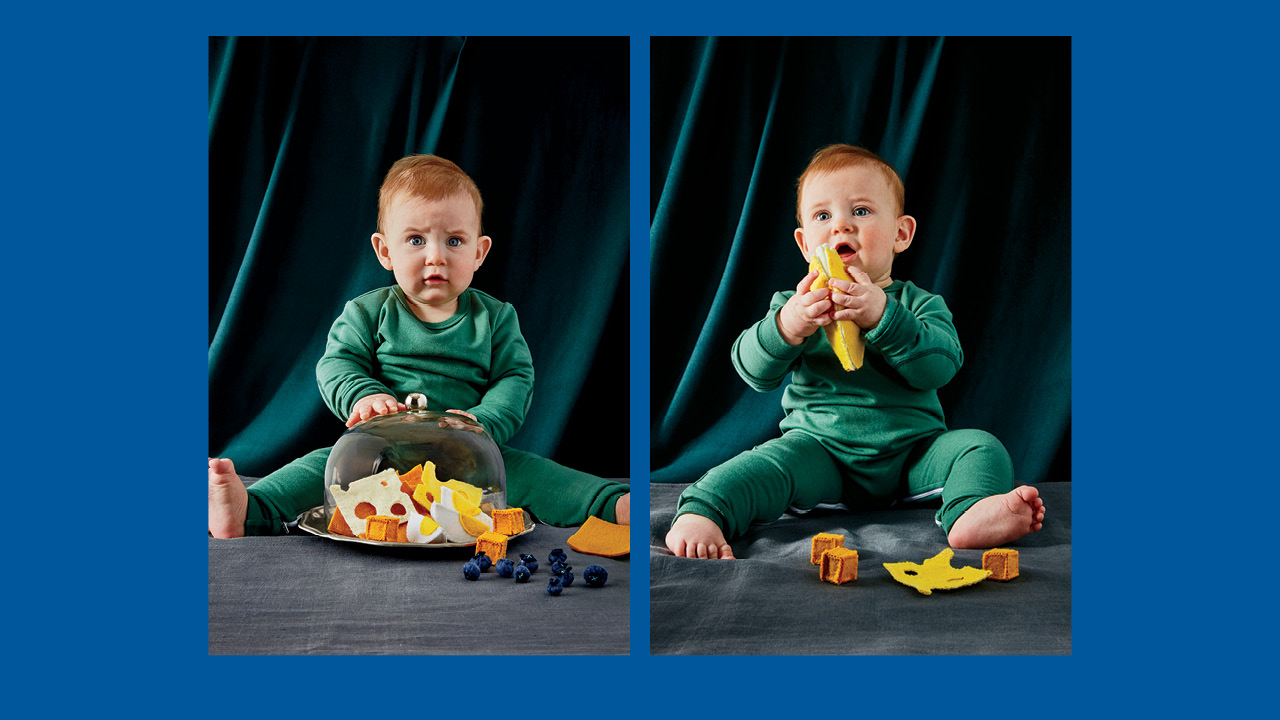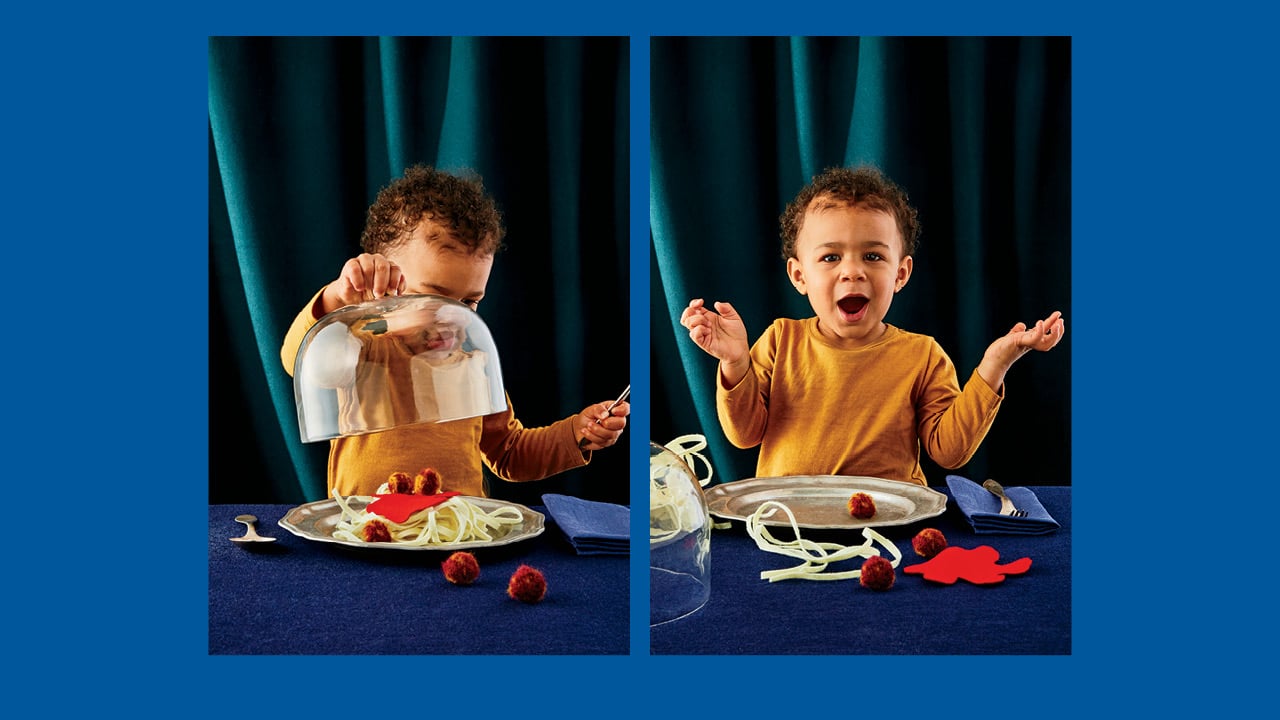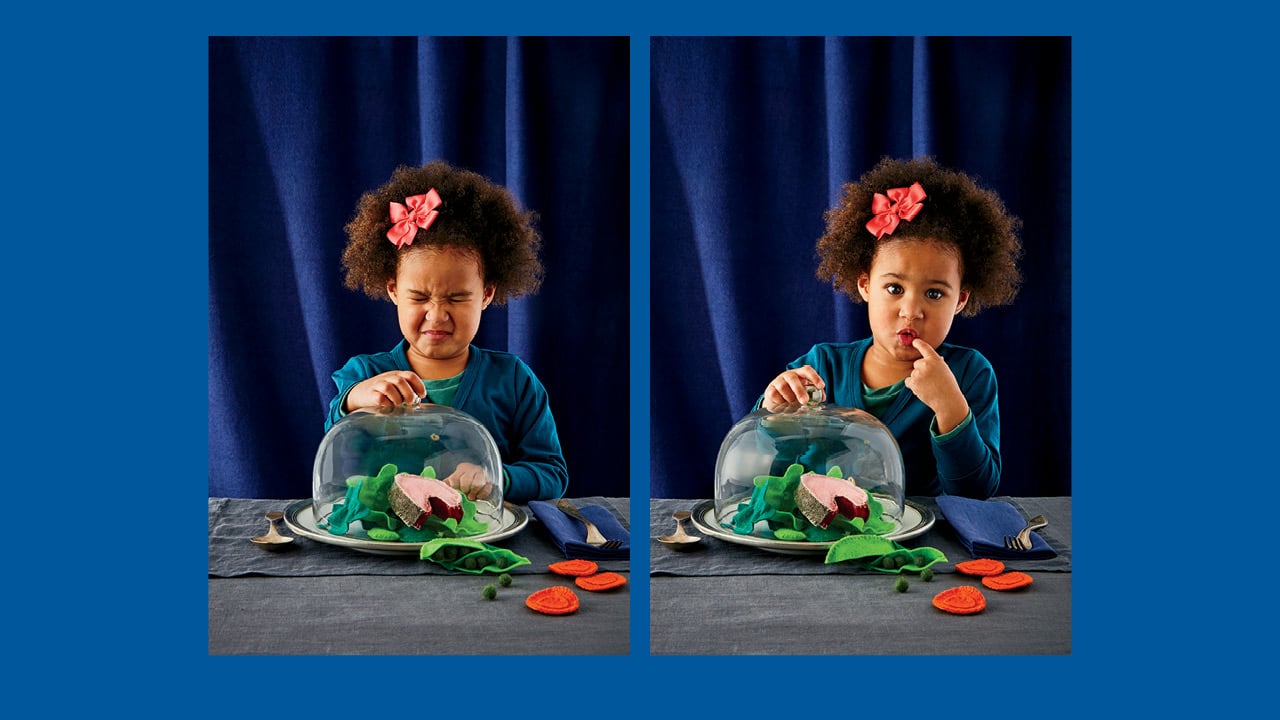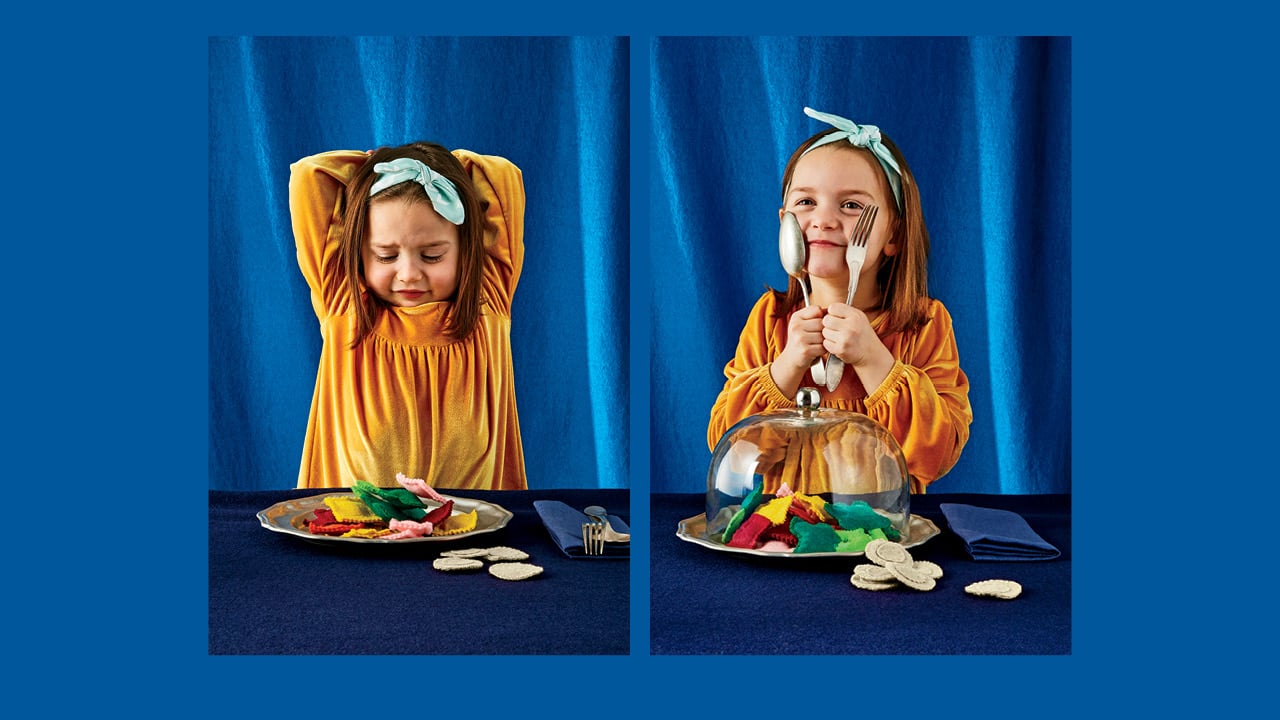What Age to Stop Feeding Kids
Two Canadian dietitians (and moms!) reveal their top tips, tricks, advice and parent hacks for feeding children, from six-month-old babies to six-year-old big kids.
Feeding kids doesn't sound like it should be complicated: You make meals; they eat them. But the reality can be just a bit different. There's a lot for new parents to learn—not just what to feed the littles, but how to feed them (and how not to). In this excerpt from the new Canadian parenting guide Food to Grow On, registered dietitians and moms Sarah Remmer and Cara Rosenbloom walk you through tips and tricks for feeding children, from babies to bigger kids.
Power plays: Is your kid eating enough?
The No. 1 most important thing to know about feeding your kids applies to children of all ages, even babies.
Many parents have trouble believing that a child can choose how much or if they want to eat—we're part of a culture that tells kids to "clear your plate" or take "just one more bite." But our kids are born intuitive eaters—they know how much they need and when to stop—so we must trust this. By offering five to six eating opportunities a day (meals and snacks), with lots of variety, we can rest assured that our little ones will meet their nutrition needs over the period of a week, rather than focusing on any one specific meal. This makes for a much more pleasant eating experience and nurtures your child's natural ability to eat intuitively.
This philosophy is known among dietitians as Satter's division of responsibility. We've seen it work time and time again—in fact, thousands of times!—in nutrition counselling practices and with our own kids. Please try it. And trust it. And be patient. It may take weeks or months for an older child to grow accustomed to it, but we promise that it does work!
Put simply, in Satter's division of responsibility, parents are responsible for some things, while kids—no matter how old they are—are responsible for others.
Parents decide:
• What is served to eat
• When it is served
• Where it is served
Babies and children decide:
• If they want to eat
• How much to eat

Photo: Carmen Cheung
Babies (6 to 12 months)
10 tips for starting solids with your new eater!
1. Introduce solids. Baby is ready to eat solid foods by six months.
2. Choose the first food. Baby cereal, fruits, vegetables, meat, beans—anything goes for the first taste of food.
3. Choose iron-rich foods. Baby needs iron-rich foods at least twice a day.
4. Limit rice cereal. Try iron-enriched infant whole grain, barley or oatmeal cereal instead.
5. Be aware that some foods are choking hazards. Take an infant CPR course.
6. Feed with the combo method. Try both spoon-feeding and letting baby self-feed soft finger foods, even at the same meal.
7. Know that gagging is normal. It's a natural reflex that prevents choking. Stay calm, and baby will be calm, too.
8. Don't delay allergenic foods. Peanuts, tree nuts, milk, eggs, soy and other possible allergens should be introduced at six months.
9. Know your role. Let baby be responsible for how much they eat. Don't force-feed!
10. Introduce a cup. At six months, try a bit of water in a regular cup. It will be messy at first, but baby will learn quickly.
What to offer as first foods for baby
Traditionally, iron-fortified single-grain cereal thinned out with breastmilk or formula was the gold-standard first food for baby. Although it's still an option, it is no longer the only choice. The most important thing to remember is to make iron-rich foods the priority when starting solids. Baby's iron stores are becoming depleted at six months and they require this nutrient from food for proper growth and development.
AGE 6 TO 7 MONTHS
Protein/iron-rich:
Cooked meat and poultry: Puréed, minced and shaped into meatballs or patties, or slow-cooked then shredded.
Low-mercury fish: Deboned and cooked until soft, then puréed or shaped into patties.
Eggs: Hard-boiled then mashed; cooked as an omelette and cut into strips; or scrambled.
Beans, lentils or chickpeas: Cooked and then mashed or puréed.
Cheese: Grated or thinly sliced.
Yogurt: Plain or Greek
Fruits and vegetables:
Soft fruits (like avocado, ripe pear or banana): Peeled and cut into large pieces. For bananas, leave half the peel on to help baby's grip.
Harder fruits and veggies (like green beans, carrots, zucchini or apples): Peeled and steamed until soft, then either mashed or puréed and spoon-fed, or cut in large pieces and served as finger food.
Grains:
Quinoa or oats: Cooked and spoon-fed, or baked into meatballs or patties.
Whole-grain bread: Toasted and cut into strips, then thinly spread with nut or seed butter.
Infant cereals: Iron-fortified.
AGE 8 TO 9 MONTHS
Continue to serve any of the foods from six to seven months, and progress to these textures when your baby seems ready.
Protein/iron-rich:
Add medium-size, soft-cooked pieces of meat, poultry and fish. Try beans and lentils made into patties.
Fruits and vegetables:
Add grated raw options, like peeled apple or carrot, and medium-size pieces of soft or steamed-soft options, like raspberries, kiwi or peach.
Grains:
Try large-flake or steel-cut oats, mixed with peanut butter and mashed banana. Offer bitesized pieces of cooked pasta, such as penne or macaroni.
AGE 10 TO 12 MONTHS
Continue to serve the foods above, and progress to these textures when your baby seems ready. Now that baby has better dexterity, the pieces can be smaller.
Protein/iron-rich:
Try smaller pieces of meat, poultry and fish. Add cooked whole beans or chickpeas and cheese cubes.
Fruits and vegetables:
Add smaller pieces of cooked vegetables, like steamed sliced carrots or steamed cauliflower or broccoli, and small slices of tender, peeled options, such as raw cucumber. Try sliced grapes and small whole blueberries, and small pieces of dried fruit, such as apricots or raisins.
Grains:
Include grains like pasta or barley in mixed meals (without added salt), such as ravioli with tomato sauce, spaghetti bolognese or soup.

Photo: Carmen Cheung
Toddlers (12 to 24 months)
10 tips for feeding your one-year-old
1. Introduce milk (here's how). Your toddler can drink cow's milk at 12 months. If you are still breastfeeding, that's great, too!
2. Use cups. By 12 months, begin to transition from bottles to cups if you haven't already. Cups with straws are better than sippy cups.
3. Teach self-feeding. Teach your toddler how to use spoons and forks (and fingers!) to self-feed.
4. Keep it fun. Reduce mealtime stress by keeping it calm. Don't hover, force-feed or pressure your toddler to eat.
5. Set a schedule. Your toddler should be enjoying three meals and two to three snacks each day to fill their small tummy.
6. Give vitamin D. Continue with vitamin D supplements (400 IU per day).
7. Know that food throwing is normal. It's a phase that will pass if you stay calm. Provide easy instructions, like "Food stays on the tray."
8. Don't label picky eaters. That moniker only reinforces the problem. Kids are learning about food. Being picky is a normal phase.
9. Avoid treats. There's no room in a 12- to 24-month-old's diet for candy, soft drinks and cake—not yet anyway. They require nutrient-rich foods to fill that precious and small tummy space.
10. Be a role model. Your toddler is watching and learning from you. Mirror healthy behaviours (yup, that means you have to eat vegetables!).
Limit-testing toddlers: Say hello to self-feeding and picky eating
Having a toddler is fun, fascinating and frustrating all at the same time, especially when it comes to eating! As your child transitions from babyhood to toddlerhood, you'll notice developmental and social changes, which can impact their eating habits, too. With better balance and coordination, and the desire to master fine motor skills, self-feeding becomes easier.
Plus, their newly developed sense of self will help them actually want to control more of their own food intake. It's a good thing! During toddlerhood, you'll help your child to wean off bottles, learn to drink from a cup and successfully feed themselves with a spoon (if they are not doing those things already).
You'll probably notice that your toddler's eating habits become a bit more unpredictable, too. At this stage, kids' appetites and food intake may start to slow down along with their growth, which is totally normal. But it typically means they become more selective about their food choices as they yearn for independence and control—enter: picky eating! Your toddler may love a food one day but refuse it the next, toss an entire bowl of freshly cooked oatmeal on the floor or throw a tantrum at the sight of a previously loved food. It's all part of the process of learning to eat, and it does pass.
It's important to offer your toddler nutritious meals and snacks at regular and predictable intervals (about every two to three hours). Try to stay relatively consistent with your schedule so that your child learns that eating isn't a free-for-all, but something that happens at roughly the same times every day. This will help them develop a healthy meal pattern so they don't graze all day or say "hungry!" and ask for food. Consistency is key.
At this stage, establishing mealtime boundaries around what, when and where they eat is important so that your toddler can learn how to manage their hunger and fullness (self-regulate) and eat intuitively. The more regular and predictable your meal and snack timing can be (with a bit of flexibility, of course—let's be real), the easier it is for young toddlers to learn how to manage their appetite and food intake.
How much is enough (or too much)? Toddlers need about 1,300 calories per day. But we certainly do not want you counting your toddler's calories! As long as you're following Satter's division of responsibility, your toddler should get what they need.

Photo: Carmen Cheung
Preschoolers (2 to 3 years old)
10 tips for feeding two- to three-year-olds
1. Have a routine. Offer meals and snacks at the same time each day to establish a pattern and avoid all-day grazing.
2. Eat as a family. Be a role model for healthy eating while enjoying family time.
3. Make vegetables yummy. Offer dips, try different textures or serve as a soup.
4. Don't sneak in the veggies. Cook with your kids to show them the ingredients.
5. Wiggly kid? Bring back the high chair! Kids can't sit for more than 10 to 20 minutes at a meal, and they need a properly positioned chair.
6. Offer vegetables often. Kids will learn to eat vegetables with repeated exposure. You can be the role model.
7. Follow their appetite. Remember Satter's division of responsibility: You serve healthy foods and let kids decide how much to eat.
8. Accept that messy eating is normal. It's fine for kids to explore food, but it's also fine to set boundaries so it doesn't get out of hand.
9. Don't use treats as rewards. A treat once in a while is fine, but not as a bribe or prize for good behaviour.
10. Shop and cook together. Get your kids involved in mealtimes.
Picky eaters
After the age of two, growth starts to slow and stabilize a bit, and toddlers come out of their critical nutrition period, which means their food intake and appetite diminish. Combine this with their newly discovered independence and desire for control, and it easily translates into—you guessed it—mealtime battles.
We can relax, though, because most of the time, kids get the nutrition they need over the period of a week, even though it appears they eat next to nothing on certain days. As long as you're serving a nice variety of nutritious foods throughout the week, it will all balance out.
Here's a little nugget of information that might ease your mind, too: It would be unusual if your child wasn't a "picky eater" to some extent at this stage. You're not alone in this struggle! Kids in this age group often turn their noses up to foods like meat, vegetables and even (surprisingly) fruit, after they've readily accepted them as babies and young toddlers. It's normal—don't worry.
The key is to be patient, calm and positive. The way you react to typical toddler feeding challenges can either create bigger, more serious eating issues down the road or it can help your child grow their relationship with food in a healthy way. This is the stage when unhealthy feeding and eating patterns can develop and worsen, especially if there's a lot of pressure, coercion or negative energy at the table.
It's imperative that the mealtime dynamic remains positive. You don't want the focus to be on "getting my kid to eat"! You want to focus on spending quality family time together, modelling healthy eating habits and making mealtimes positive.
Treat monsters
It's perfectly fine for kids to enjoy sweet treats. Here's how to avoid them getting obsessed.
Offer randomly Offer sweet foods when it makes sense to you and for your family, but do this randomly. Don't make a big deal out of it. You don't want your child to associate treats with a particular day, time or meal, or they will start to crave them at that time.
Don't restrict too much If kids feel treats are being withheld from them, it could trigger the "get it in while you can" mentality. You don't want your toddler "saving up" for or expecting treats.
Avoid using as a reward We know how tempting it is to use this strategy to bribe or reward kids, but doing so only increases treats' desirability and puts them on a pedestal.
Separate dinner and dessert Rewarding your toddler with dessert foods because they ate their vegetables at dinner is communicating that vegetables are to be avoided and desserts to be desired, and may cause them to rush through the meal to get to the treat more quickly.
Decide on the amount There's no rule about how often or how much when it comes to offering treats. It's important that nutrient-dense, whole foods fill precious tummy space first and foremost, and treats are the fun add-on.

Photo: Carmen Cheung
Big kids (3 to 6 year olds)
10 tips for feeding your schoolagers.
1. Serve whole, unprocessed foods most often. Cut back on ultra-processed foods.
2. Assemble a balanced lunchbox. Add vegetables, fruits, whole grains and protein-rich foods.
3. Serve water as the main beverage. Juice and soft drinks are treats—like candy!
4. Teach the "balanced plate." Fill half with vegetables and fruits, a quarter with grains and a quarter with protein.
5. Stay active. Kids should have at least 60 minutes of physical activity every day.
6. Cook with your child. Teach them some age-appropriate kitchen tasks and remain calm about the mess!
7. Do not put kids on weight-loss diets. Encourage a healthy lifestyle instead.
8. Foster good self-esteem. Inspire your child to list what they love about themselves.
9. Know that vegetarian and vegan diets are safe. Assure adequate protein, iron and vitamin B12.
10. Be flexible, not restrictive. Food is never the enemy.
The always-on junk food battle
Kids at this stage can eat mostly everything—but that doesn't mean they will. There's a broad spectrum, from kids who enjoy a small handful of foods to kids who will try anything once. What's most important is that your child stays nourished by choosing foods that contain the nutrients their bodies require for normal growth and development.
Here's the bad news: Kids at this age tend to eat a lot of ultra-processed foods—things like cookies, hot dogs, soft drinks, chicken nuggets, cake and chips. Why is this a problem? A high intake of ultra-processed foods is linked to an increased risk of chronic diseases like type 2 diabetes, high blood pressure and heart conditions.
So, what should kids be eating? The following foods are nutrient-rich, and because kids have high-nutrient needs but small stomachs, these foods should fill most meals:
- Vegetables
- Fruits
- Meat and poultry
- Fish and seafood
- Eggs
- Legumes and pulses: chickpeas, black beans, lentils, tofu, peanuts
- Dairy: milk, kefir, yogurt, cheese
- Nuts: almonds, cashews, pecans, walnuts, nut butters
- Seeds: hemp, pumpkin, sesame, sunflower, chia, seed butters
- Whole grains: oats, quinoa, barley, rice, wholegrain wheat
- Healthy oils: olive, avocado, sesame
Excerpted from Food to Grow On on by Sarah Remmer and Cara Rosenbloom. Copyright © 2021 Sarah Remmer and Cara Rosenbloom. Published by Appetite by Random House®, a division of Penguin Random House Canada limited. Reproduced by arrangement with the publisher. All rights reserved.
mendozabillostrand.blogspot.com
Source: https://www.todaysparent.com/kids/kids-health/age-by-age-guide-to-feeding-babies-toddlers-and-kids/
0 Response to "What Age to Stop Feeding Kids"
Postar um comentário